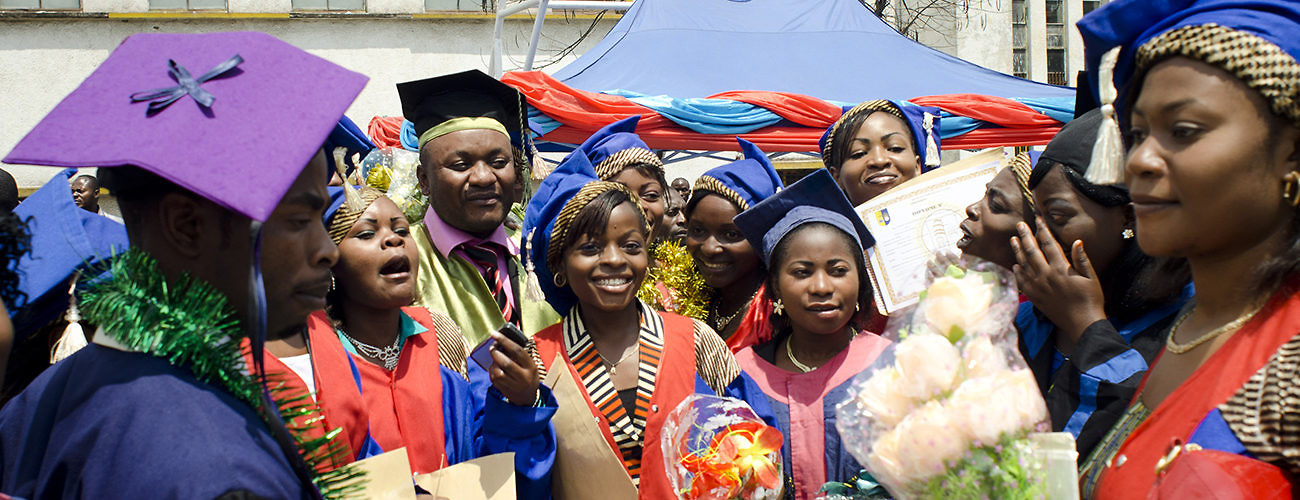Students celebrate graduating from the Institut Superieur du Commerce. Goma, Democratic Republic of the Congo, August 10, 2012. (Michelle Sibiloni/AFP/Getty Images)
Africa, as former United Nations Secretary-General Kofi Annan said more than a decade ago, reveals a combination of accomplishments and unresolved problems, of opportunities seized, and chances missed. This is perhaps even more relevant today, as the continent’s institutions and states are in the midst of a long-term transition that is as much a result of globalization and the communications revolution as of policies and decisions by contemporary African leaders.
The broad direction is to a more democratic state system with fewer conflicts, better governance, and a strengthened focus on the rule of law. The current global migration crisis underscores this reality: most African migrants seeking to enter Europe are coming from a few countries in eastern Africa and Nigeria, with virtually none from the south of the continent. Where there is a modicum or more of good governance, as throughout southern Africa, people are staying in their own countries.
Old Challenges
The forces of change in Africa have been underway since the end of the Cold War 26 years ago, when intrastate conflicts were rife and hard to resolve. At the political level, the transition was marked by the transition from the Organisation of African Unity (OAU) to the African Union in 2000, with the adoption of a new normative agenda authorizing it to intervene in cases of war crimes, genocide, and crimes against humanity. This important step was in large part a response to the failure and inability of the OAU to prevent the collapse of the Somali state in 1992-1993 and the genocide in Rwanda in April 1994, in which 800,000 people died in less than a month. Importantly, the AU’s Constitutive Act was adopted five years before the adoption of the “Responsibility to Protect” doctrine by the United Nations General Assembly in December 2005.
Since 2000, the AU has authorized peace operations and interventions in five conflicts: Somalia, Mali, Darfur, Burundi, and the Central African Republic, subsequently ceding responsibility for most of these to the UN. AMISOM, a strictly AU operation, is still operating in Somalia with support from the UN, the European Union, and the United States. At the same time, African leaders continue to struggle to defeat Islamic insurgencies mounted by al-Shabaab in Somalia and Boko Haram in Nigeria and the Lake Chad Basin. Leaders remain critical of the International Criminal Court for focusing on African cases of crimes against humanity and war crimes, rather than extending its prosecutions to other continents. Nonetheless, no African state has withdrawn from the ICC’s Rome Statute.
The AU is still struggling to translate the principles of conflict prevention and democratic transition to ongoing electoral processes in Burundi and the Democratic Republic of the Congo, whose leaders Pierre Nkurunziza and Joseph Kabila have extended, or are seeking to extend, their terms in office. It is widely expected that Paul Kagame and Yoweri Museveni will also seek to extend their tenures in Rwanda and Uganda. Ongoing crises in South Sudan and Somalia underscore the difficulties of enforcing AU or UN initiatives at conflict resolution, and obtaining the concurrence of intractable African leaders, while many thousands of their citizens suffer in makeshift refugee camps.
New Trends and Attitudes
The main drivers of change are members of the new generation of Africans, who are in touch with the world through the communications revolution and attending public and private universities in greater numbers than ever before. While a lower rate than elsewhere in the world, 54% of Africans have access to mobile phones, with over 35 mobile phone operators providing more than 754 million connections in sub-Saharan Africa. Primary school enrollment has increased from 59% to 79% of young people between 1999-2010, although there are still fewer girls than boys in school. Most significantly, the number of public universities has doubled from 100-200 in this period, with more than half of these in Francophone countries; the largest number are in Senegal and the DRC. In Anglophone Africa there are 79 universities in South Africa alone, including participation by students from Zimbabwe and elsewhere in the region.
In a significant, albeit small sample, 97 out of 100 students who have participated in the Kings College/African Leadership Centre program—with which the International Peace Institute is affiliated, and whose aim is to develop a new generation of African leaders—have continued to work on the continent. They have a wide range of responsibilities, from mid-level positions in the AU and the continent’s regional economic communities, to serving in municipal government and university faculties, as well as in the private sector as lawyers and journalists.
There are signs, too, of African policymakers being willing to take on more responsibility for the continent’s affairs. The AU’s recent adoption of the “Kaberuka proposals,” for example, saw African states agree to fully cover the regional organization’s administrative costs and 25% of the cost of its peace operations. This is an important step to Africans asserting greater independence and control of their own destinies.
In sum, even as old challenges persist, the rise of a new generation of African leaders, greater access to global communications, and new trends in African academic and research initiatives, portend a better future for the continent.





